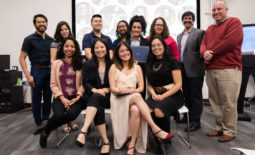AAJA Seattle student member: AAJA Convention gave feeling of “renewed hope” in journalism

[Mary Pauline Diaz, far left, with fellow Northwest Journalists of Color Scholarship winners Katelin Chow and Peter Sessum and AAJA co-founder Bill Sing during the 2010 AAJA National Convention in Los Angeles.]
Mary Pauline Diaz, a 2010 Northwest Journalists of Color Scholarship winner, spent her summer writing for the Seattle Weekly. As a recipient of AAJA Seattle’s Founders Scholarship, Diaz she also was able to attend the 2010 AAJA National Convention in Los Angeles in August. As AAJA Seattle’s student members return to school, Diaz, a junior at Seattle University, shares why she returns with a renewed confidence in her career path.
It’s easy to feel daunted and overwhelmed by the changing state of the journalism, especially at this point in time. But at the AAJA National Convention, the language and the feeling definitely exuded a renewed hope. As a nervous convention first-timer and forward-minded student, it was refreshing to be around so many journalists who were excited about the future of journalism, who had enough passion to propel themselves past hurdles or who were gearing up for the hurdles they were facing: unemployment for seasoned vets, first forays into a fickle field for students and recent grads and the utter volatility of the industry for everyone.
And that’s not the only good news. The good news (and I think this is good news) is that journalism as we know it is being turned on its head. I jotted down a few quotes from some convention workshops that totally threw me for a loop, but they indicate exactly how journalism itself is being redefined and regenerated.
Get excited. The time in front of us is the perfect time to experiment, reexamine our roles and position yourself for the upper hand in the market.
“New media, digital media, perhaps even journalism don’t really apply as terms for what I do.” – John Bracken, Director of New Media at The Knight Foundation
Let go of those traditional conceptions of your job description. Regardless of what Bracken himself does, every journalist has to face the transitioning ambiguity of what journalism is, what media is and what audiences consider their sources of information.
“Audio is really a visual medium.” – Sora Newman, Senior Trainer at NPR
Though every format and every story is unique, the richest part of a converging media market is indeed the convergence. It’s not just about the parts sitting beside each other but the way they meld and speak to each other. Newman and the others on the Audio Storytelling for Print Journalists panel challenged participants to look beyond the verbal portion of audio stories and to capture the ambient sounds and bits that paint that “picture” for the listener.
“Content is king, but collaboration is queen. If you think of a chessboard, the king is the most important, but, let’s be honest, the queen is most powerful.” – David Cohn, Spot.us
The most hopeful thing to hear over and over again at the convention was the call to collaborate, a particular theme of the hyperlocal news panel featuring Cohn. Especially as citizen journalism grows and culture’s demand for transparency and immediacy grows, the spirit of collaboration not only grows in importance but in creativity. Spot.us, for instance, uses a unique model of collaborative funding — freelancers can pitch stories, and community members can pitch in the cash.
“It’s not about what the staff is doing. It’s about what the reader is experiencing.” – Wasim Ahmad, Multimedia Journalist and Assistant Professor at Stonybrook University
So often we get caught up in what all of this change means for our jobs and our futures, but journalists should really be mindful of what the changing media landscape means for the audience — not only in how it will change the way people receive information but also the way people interact with information and what they choose to do with it.
“The business of journalism is the business of relationships.” – Raja Abdulrahim, Staff Writer at Los Angeles Times
“You’re not just a journalist. You’re a human being.” – Eiji Yamashita
I put these two together because they pull at a similar issue. So often do we, in the pressure to remain objective, lose sight of the communities and people who are affected the most. It’s not impossible to be both empathetic and fair, and perhaps empathy is intrinsic to justice. Our work as journalists are strengthened by nurturing relationships and trust with the people around us.
“This is not news in one point in time. I want to tell a story with an arc.” – Christopher Wong, Filmmaker of Whatever It Takes
Especially with tools like Twitter, there’s a lot of hype around up-to-the-minute bites (or bytes) of news, quick snippets of information. And the reality is, there’s definitely a demand for that in this fast-paced world. Yet as we reimagine different ways to make the news, we gain more opportunities to harness the power of a compelling story, something that isn’t just informative in an intellectual and utilitarian sense but something that speaks to the bigger picture.

